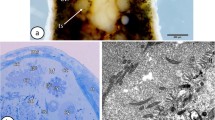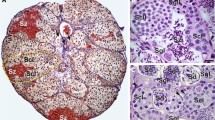Summary
The fine structure of Sertoli cells in three marine prosobranch molluscs has been studied with light- and electron microscopy. Sertoli cells of prosobranchs are modified columnar epithelial cells that maintain continuous contact with the basal lamina and extend from it to the lumen of a testicular tubule. Spermatogenesis takes place between adjacent Sertoli cells, but a continuous layer of cytoplasm separates the spermatogonia from the basal lamina, thus restricting the basal compartment to spermatogonium mother cells. Substances traversing the basal lamina from the interstitial space must pass either through or between the Sertoli cells. However, between the cells, a permeability barrier composed of septate and desmosome-like junctions blocks the passage of substances, such as the tracer lanthanum nitrate. The basally-located nucleus is irregularly shaped with fine granular euchromatin and some peripheral heterochromatin; satellite karyosomes border the nucleolus. There is an extensive intracellular digestive system that is used effectively to phagocytize waste sperm and residual cytoplasm. Cytoplasmic processes of Sertoli cells penetrate throughout the germinal epithelium. In some prosobranchs that exhibit sperm polymorphism these processes must coordinate to bring together a clone of eupyrene sperm and a carrier sperm at a particular time in development. The only cytoskeletal elements available within the processes to generate such movements are microtubules.
We propose that the term ‘nurse cell’, which has been used in the past to describe at least three different cell types, including Sertoli cells and apyrene sperm, be restricted to abortive oogonia that contribute to development of an oocyte.
Similar content being viewed by others
References
Abraham M, Rahamim E, Tibika H, Golenser E (1980) The blood-testis barrier in Aphanus dispar (Teleostei). Cell Tissue Res 211:207–214
Anelli G, Franchi F, Camatini M (1985) Structure and possible functional role of septate junctions in the ovotestis of a pond snail: inter-Sertoli junctions. J Submicrosc Cytol 17:213–222
Ankel WE (1930) Die atypische Spermatogenese von Janthina (Prosobranchia, Ptenoglossa). Z Zellforsch 11:491–608
Baccetti B, Bigliardi E, Talluri MV, Burrini AG (1983) The Sertoli cell in lizards. J Ultrastruct Res 85:11–23
Bergmann M, Greven H, Schindelmeiser J (1984) Tight junctions in the ovotestis of the pond snail Lymnaea stagnalis (L.) (Gastropoda, Bosommatophora). Int J Invert Reprod Dev 7:291–296
Bickell LR, Chia F-S, Crawford BJ (1979) A fine structural study of the testicular wall and spermatogenesis in the crinoid Florometra serratissima (Echinodermata). J Morphol 166:109–126
Buckland-Nicks JA, Chia F-S (1977) On the nurse cell and the spermatozeugma in Littorina sitkana. Cell Tissue Res 179:347–356
Buckland-Nicks JA, Williams D, Chia F-S, Fontaine A (1982) Studies on the polymorphic spermatozoa of a marine snail. I. Genesis of the apyrene sperm. Biol Cell 44:305–314
Burgos MH, Vitale-Calpe R (1967) The fine structure of the Sertoli cell-spermatozoan relationship in the toad. J Ultrastruct Res 19:221–237
Cummings MR, King RC (1970) Ultrastructural changes in nurse and follicle cells during late stages of oogenesis in Drosophila melanogaster. Z Zellforsch 110:1–8
Dohmen MR (1983) Gametogenesis. In: Wilbur KM, Verdonk NH, van der Bigglaer JAM, Tompa AS (eds) The mollusca, Chapter 1. Academic Press, New York, London, pp 1–40
Dym M, Fawcett DW (1970) The blood-testis barrier in the rat and the physiological compartmentalization of the seminiferous epithelium. Biol Reprod 3:308–326
Fawcett DW (1975) Ultrastructure and function of the Sertoli cell. In: Hamilton DW, Greep RO (eds) Male reproductive system section 7. Handbook of Physiology. Vol V. Washington DC, American Physiology Society, pp 21–55
Hayden J, Allen RD, Goldman RD (1983) Cytoplasmic transport in keratocytes: direct visualization of particle translocation along microtubules. Cell Motil 3:1–19
Jong-Brink M de, Boer HH, Hommes TG, Kodde A (1977) Spermatogenesis and the role of the Sertoli cells in the freshwater snail Biomphalaria glabrata. Cell Tissue Res 181:37–58
Jong-Brink M de, Schot LPC, Schoenmakers HJN, Bergamin-Sassen MJM (1981) A biochemical and quantitative electron microscope study on steroidogenesis in ovotestis and digestive gland of the pulmonate snail Lymnaea stagnalis. Gen Comp Endocrinol 45:30–38
Jong-Brink M de, With WD de, Hurkmans PJM, Bergamin-Sassen MJM (1984) A morphological, enzyme-cytochemical, and physiological study of the blood-gonad barrier in the hermaphroditic snail Lymnaea stagnalis. Cell Tissue Res 235:593–600
King M (1979) Epithelial conduction and crumpling in a medusa. Ph.D. Thesis, University of Alberta, Edmonton, Canada, pp 6–8
Kulshrestha SR (1970) Histology of the ovarioles and the role of nurse cells in corpus luteum formation in Philosamia cynthia ricini (Boisd.) (Saturniidae: Lepidoptera). J Nat Hist 4:189–197
Lane NJ, Skaer H leB (1980) Intercellular junctions in insect tissues. Adv Insect Physiol 15:35–213
Linke O (1933) Morphologie und Physiologie des Genitalapparates des Nordsee Littorinin. Helgol Wiss Meeresunters 19:1–60
Nishiwaki S (1964) Phylogenetical study on the type of the dimorphic spermatozoa in Prosobranchia. Sci Rep Tokyo Kyoiku Daigu 11:237–275
Osman DI, Ekwall H, Ploen L (1980) Specialized cell contacts and the blood-testis barrier in the testicular tubules of the domestic fowl (Gallus domesticus). Int J Androl 3:553–562
Reinke EE (1912) A preliminary account of the development of the apyrene sperm in Strombus and of the nurse cells in Littorina. Biol Bull Mar Biol Lab Woods Hole 22:319–327
Renault L (1965) Observations sur l'ovogenèse et sur les cellules nourricières chez Lamellaria perspicua (L.) (Mollusque: Prosobranche). Bull Mus Nat Hist Nat 37:282–284
Ribbert D, Bier K (1969) Multiple nucleoli and enhanced nucleolar activity in the nurse cells of the insect ovary. Chromosoma 27:178–197
Richardson FC, Jarett L, Finke EH (1960) Embedding in epoxy resins for ultrathin sectioning in electron microscopy. Stain Technol 35:313
Roosen-Runge EC (1976) The process of spermatogenesis in mammals. Cambridge Univ Press, Cambridge, pp 18, 46
Russell LD (1980) Sertoli-germ cell interrelations: a review. Gamete Res 3:179–202
Russell LD, Peterson RN (1985) Sertoli cell junctions: morphological and functional correlates. Int Rev Cytol 94:177–211
Sachwatkin V (1920) Das Urinogenital-System von Ampullaria gigas. Spix. Acta Zool 1920:67–130
Serra JA, Koshman RW (1967) Nuclear changes of treptional nature in the differentiation of sperm nurse cells in snails. Can J Genet Cytol 9:23–30
Sertoli E (1865) Dell 'esistenza di particolari cellule ramificate nei canalicoli seminiferi del testicolo umano. Morgagni 7:31–40
Setchell BP, Waites GMH (1975) The blood-testis barrier. In: Hamilton DW, Greep RO (eds) Male reproductive system, section 7. Handbook of Physiology, Vol V. Washington DC, American Physiology Society, pp 143–172
Szollosi A, Marcaillou C (1977) Electron microscope study of the blood-testis barrier in an insect Locusta migratoria. J Ultrastruct Res 59:158–172
Takashima Y (1968) Electron microscopic observations on the nurse cells in sea urchin ovary. Med J Osaka Univ 19:113–126
Vogl AW, Soucy EJ (1985) Arrangement and possible function of actin filament bundles in ectoplasmic specializations of ground squirrel Sertoli cells. J Cell Biol 100:814–825
Vogl AW, Linn YC, Dym M, Fawcett DW (1983) Sertoli cells of the golden-mantled ground squirrel (Spermophilus lateralis): A model system for the study of shape change. Am J Anat 168:83–98
Woodard TM (1940) The function of the apyrene sperm of Goniobasis. J Exp Zool 85:103–126
Yasuzumi G (1974) Electron microscope studies on spermiogenesis in various animal species. Int Rev Cytol 37:53–119
Yasuzumi G, Tanaka H, Tezuka O (1960) Spermatogenesis in animals as revealed by electron microscopy. VIII. Relation between the nutritive cells and the developing spermatids in a pond snail, Cipangulopaludina malleata Reeve. J Biophys Biochem Cytol 7:499–504
Author information
Authors and Affiliations
Additional information
This paper was cited in a previous publication (Buckland-Nicks et al. 1982) under the title: “A comparative investigation into the relationship between Sertoli cells, eupyrene and apyrene sperm in the testis of two marine snails”
Rights and permissions
About this article
Cite this article
Buckland-Nicks, J., Chia, FS. Fine structure of Sertoli cells in three marine snails with a discussion on the functional morphology of Sertoli cells in general. Cell Tissue Res. 245, 305–313 (1986). https://doi.org/10.1007/BF00213936
Accepted:
Issue Date:
DOI: https://doi.org/10.1007/BF00213936




